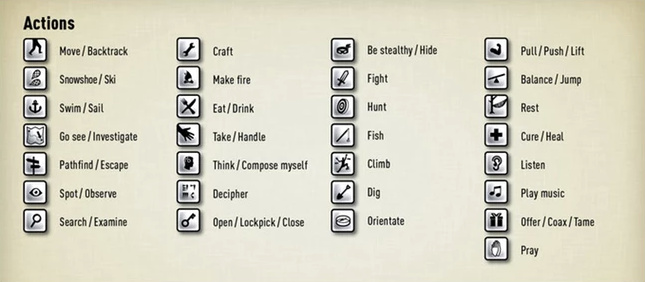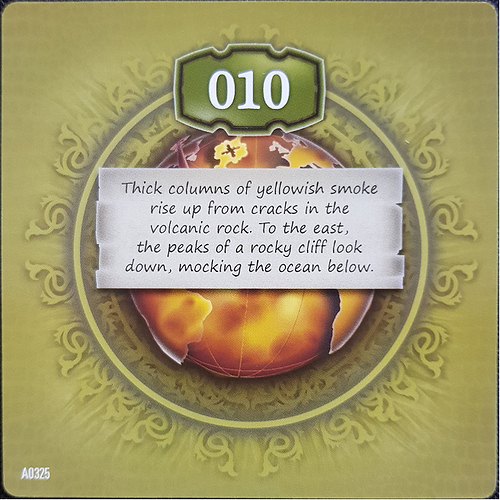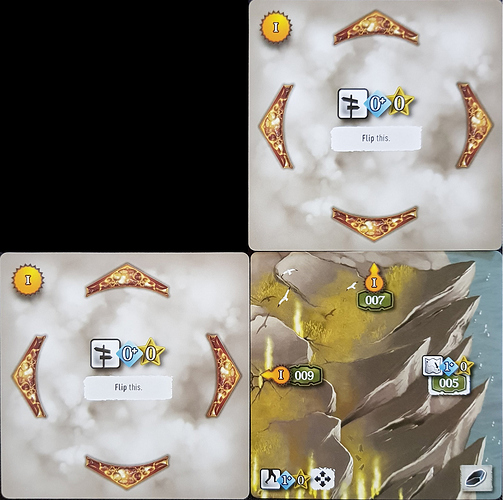Okay, you asked for it. :)
Do you like exploring and discovering new things? You know those legacy games, where you regularly rip something open to get something new? To me every turn in this game feels like that. The map, the story, the mechanics, all are revealed gradually as you play. It’s like everything is unknown and the possibilities are endless! There’s a strong point-and-click adventure game vibe here, made analogue with some survival mechanics to push the player along.
I’ll only show starting cards below so no real spoilers
You pick one (or more) of the characters, who each have 5 custom skill cards focusing on a particular bunch of actions that are in-line with their backgrounds and personalities.
You’re given a clue, which in this first case shows the general path to take along with some landmarks and clues for the journey. Note that none of this terrain is yet known to the player:
Cards often have story text on their backs, so you get to read a few descriptive lines before flipping it to see the art and consequences. Here’s the starting card:
Then you turn it over and lay it down, placing ‘fog of war’ cards where the exits are:
Note you’re not laying down random tiles here, you’re exploring and slowly revealing a massive hand-crafted world map (given the number of cards it’s likely massive, I haven’t peeked at spoilers). The ‘fog of war’ in each available direction costs nothing to explore/uncover, but the flip side of the card often has a random event that you must resolve before placing the actual terrain down.
It’s quite monumental. There are nearly 1000 cards and roughly 800 of those have unique artwork. Parts of the map art are functional and reward observation. See the animal tracks to the south? Hmm… Some have hidden card numbers, some ask you to solve a little puzzle and choose an option based on your deduction. The card you reveal can change based on quest items you find. It’s really well thought out.
Each piece of terrain has a bunch of actions (the white boxes) you can perform while there. There’s often a few per tile along with movement and any attached FoW exploration.

Each white box shown on a card usually leads to a bunch of other cards giving you decisions to make and things to find.
Each action shows the amount of cards you draw from a blue action deck to try and pull the ‘successful’ yellow stars. For the fight action below, you draw 2 or more cards and need to pull at least 1 success (the odds of this are shown in a table in the rules).

This blue action deck you’re drawing from is made up of useable skills and items that can be crafted and combined. Every time you pull blue cards for an action test, you choose one of them to add to your hand. Some of these are skills that can be discarded during an action to use their effects. Some are ‘blueprints’ that can be crafted into items and combined with other items in your inventory. Most of them relate to one or more actions, so can be used to manipulate results when performing those actions.
The inventory system is kind of clever. In solo play using a single character you can store four items, each consisting of a stack of up to four cards. Each stack has a ‘durability’ which governs the number of uses you get for each stack. If you add a new card to an item stack and it has a keyword that matches the top card, you get to increase the durability so the item has more uses, as well as more functionality for each use (since the entire stack activates when used).
It doesn’t make a hell of a lot of sense thematically but it’s cool mechanically, because there are a lot of potential actions in the game so you need to kind of balance current priorities based on the environment you’re in, maintain the durability on the most useful items for the current situation, think about action specialisation vs covering more bases, and try to leave spaces for new stuff to be added.
So you’re drawing all these blue cards for action checks, getting skills and crafting stuff, but the catch of course is that this blue card deck is actually your health/stamina as well, and if it runs out you are close to the dreaded ‘game over’.
‘Surviving’ then is looking for ways to manipulate the number of cards you draw, increase the successes you get, and trying to move cards from the discard pile back into the draw deck.
For example a hunt action may reward you with food items, which when eaten could transfer 3 discarded cards back into your draw deck. If you first start a fire, you could double the cards that get returned - cooked food is more nourishing! But hunting and starting fires also take action tests too! Hmm, maybe you’ve crafted something that allows you to reduce the card draw and give free successes for hunting or fire-starting actions? Now using those items will reduce the durability of the whole item stack by 1…
As you explore you may also get XP cards. You can spend XP to purchase additional cards from a stack of ‘advanced’ blue skills, that can then be added to your hand - or more importantly shuffled into the action deck to stave off death that little bit longer. One neat touch with these XP cards is that each of them has a different survival tip written on the front, kind of like what you’d see with loading screen tips in a video game. As the character is gaining experience, the player is gaining knowledge - nice attention to detail.
And all this base cardplay mechanical stuff is like the moment-to-moment gameplay that happens while you’re trying to resolve the situation in the immediate area, as well as the overarching puzzle of the current story you’re playing. I’m only through the ‘tutorial’ area which took a good few hours, and have barely scratched the surface of the game really. But even now I can tell this is something special…
So, exploration - check. Inventory management - check. :) It’s also got nice high production values (bar the requisite small grey minis - I prefer using the standees), it’s quick to setup, and has an elegant save/load system built in. And it has drop in/out co-op! But I’m not sure how well this would go with others - as a purely solo experience it’s quite wonderful.





